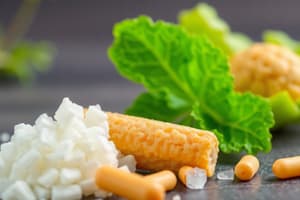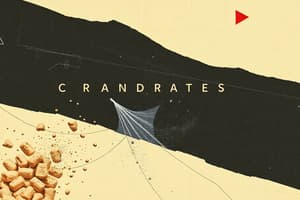Podcast
Questions and Answers
Which type of carbohydrate consists of a single sugar unit?
Which type of carbohydrate consists of a single sugar unit?
- Monosaccharides (correct)
- Oligosaccharides
- Disaccharides
- Polysaccharides
What is the general formula for many simple carbohydrates?
What is the general formula for many simple carbohydrates?
- [C6H12O6]n
- [C2H2O]n
- [CH2O]n (correct)
- [C5H10O5]n
What type of carbohydrate serves as a storage form of energy in plants?
What type of carbohydrate serves as a storage form of energy in plants?
- Glycogen
- Cellulose
- Ribose
- Starch (correct)
Which of the following carbohydrates cannot be digested by humans?
Which of the following carbohydrates cannot be digested by humans?
Which category of carbohydrates provides a rapid rise in blood sugar levels?
Which category of carbohydrates provides a rapid rise in blood sugar levels?
What is the primary biochemical role of carbohydrates?
What is the primary biochemical role of carbohydrates?
Which monosaccharide has six carbon atoms?
Which monosaccharide has six carbon atoms?
Which of the following is not a category of carbohydrate classification based on the number of sugar units?
Which of the following is not a category of carbohydrate classification based on the number of sugar units?
What type of sugar is glucose primarily classified as?
What type of sugar is glucose primarily classified as?
What is the main sugar found in fruits?
What is the main sugar found in fruits?
Which monosaccharide has no asymmetric carbon atom?
Which monosaccharide has no asymmetric carbon atom?
Which of the following correctly describes the number of optical isomers for a pentose aldose?
Which of the following correctly describes the number of optical isomers for a pentose aldose?
What kind of isomers are glucose and fructose categorized as?
What kind of isomers are glucose and fructose categorized as?
Which structural feature does fructose possess in its stable form?
Which structural feature does fructose possess in its stable form?
How does the number of asymmetric carbon atoms in ketoses compare to aldoses of the same carbon length?
How does the number of asymmetric carbon atoms in ketoses compare to aldoses of the same carbon length?
What is the role of galactose in biological systems?
What is the role of galactose in biological systems?
Which characteristic distinguishes D and L isomers?
Which characteristic distinguishes D and L isomers?
What is an example of an epimer of glucose?
What is an example of an epimer of glucose?
What does optical activity in monosaccharides depend on?
What does optical activity in monosaccharides depend on?
What happens during mutarotation of glucose?
What happens during mutarotation of glucose?
Which statement about a racemic mixture is true?
Which statement about a racemic mixture is true?
Which type of isomerism is characterized by non-superimposible mirror images?
Which type of isomerism is characterized by non-superimposible mirror images?
What defines an anomer in carbohydrate chemistry?
What defines an anomer in carbohydrate chemistry?
Which of the following compounds is not a monosaccharide?
Which of the following compounds is not a monosaccharide?
What is produced during alcoholic fermentation?
What is produced during alcoholic fermentation?
Which of the following describes the oxidation of a primary alcoholic group?
Which of the following describes the oxidation of a primary alcoholic group?
Which type of sugar is formed from the reduction of sugars?
Which type of sugar is formed from the reduction of sugars?
Disaccharides are formed by the condensation of what?
Disaccharides are formed by the condensation of what?
Which of the following disaccharides is reducing?
Which of the following disaccharides is reducing?
What type of glycosidic linkage is present in sucrose?
What type of glycosidic linkage is present in sucrose?
What do reducing sugars contain that non-reducing sugars do not?
What do reducing sugars contain that non-reducing sugars do not?
Which of the following is not an example of a derived sugar?
Which of the following is not an example of a derived sugar?
What are the hydrolytic products formed when sucrose is hydrolyzed?
What are the hydrolytic products formed when sucrose is hydrolyzed?
Why is lactose considered to be a perfect sugar for babies?
Why is lactose considered to be a perfect sugar for babies?
What is the linkage type between the glucose molecules in maltose?
What is the linkage type between the glucose molecules in maltose?
What property distinguishes lactose from yeast fermentation?
What property distinguishes lactose from yeast fermentation?
Which enzyme is responsible for hydrolyzing maltose to glucose?
Which enzyme is responsible for hydrolyzing maltose to glucose?
Flashcards are hidden until you start studying
Study Notes
Carbohydrates: Polyhydroxy Aldehydes or Ketones
- Carbohydrates are polyhydroxy aldehydes or ketones containing carbon, hydrogen, and oxygen.
- Many simple carbohydrates follow the general formula (CH2O)n, where n represents the number of carbon atoms (ranging from 3 to 8).
- The ratio of hydrogen to oxygen is 2:1.
- They are a primary source of energy, providing 4 kcal/g.
- Carbohydrates serve as a storage form of energy: glycogen in animals and starch in plants.
- They are structural components, such as glycosaminoglycans in humans and cellulose in plants.
- Non-digestible carbohydrates, like cellulose, act as dietary fibers.
- Carbohydrates are constituents of nucleic acids (RNA and DNA), including ribose and deoxyribose sugars.
- They play a role in cellular communication, immunity, and detoxification.
- Examples of food sources include grains, vegetables, fruits, milk, and dairy products.
Carbohydrate Classification
- Carbohydrates are classified into four major groups based on the number of sugar units:
- Monosaccharides (one sugar unit)
- Disaccharides (two sugar units)
- Oligosaccharides (3-10 sugar units)
- Polysaccharides (more than 10 sugar units)
Nutritional Classification of Carbohydrates
- Complex Carbohydrates (polysaccharides): Digested and converted slowly, found in lentils, beans, peanuts, potatoes, peas, corn, whole-grain bread, and cereals..
- Simple Carbohydrates (rapid rise in blood sugar levels): Include monosaccharides, disaccharides, and oligosaccharides.
Monosaccharides: The Building Blocks
- Monosaccharides are sugars that cannot be further hydrolyzed.
- They are the building blocks of all carbohydrates.
Monosaccharide Classification
1. Based on the Number of Carbon Atoms
| Number of carbon atoms | Generic name |
|---|---|
| 3 | Trioses |
| 4 | Tetroses |
| 5 | Pentoses |
| 6 | Hexoses |
| 7 | Heptoses |
| 9 | Nanoses |
2. Based on the Functional Group
| Generic name | Aldoses | Ketoses |
|---|---|---|
| Triose | Glyceraldehyde | Dihydroxyacetone |
| Tetrose | Erythrose | Erythrulose |
| Pentose | Ribose, Xylose (Epimer of Ribose), Arabinose | Ribulose, Xylulose (Epimer of Ribulose) |
| Hexose | Glucose, Galactose, Mannose | Fructose |
| Heptose | Sedoheptulose |
Biochemical and Biological Importance of Some Hexoses
1. Glucose
- Sugar of grape
- Main blood sugar
- The principle sugar utilized by tissues.
2. Fructose
- Found in fruits, honey
- Sugar of fetal blood and is the principle sugar of semen.
3. Galactose:
-
Present in combination with glucose in milk sugar (lactose).
-
Found in tissues as galactolipids and glycoproteins.
-
All Hexoses have a free functional group, making them reducing sugars.
Asymmetric Carbon Atom
- A carbon atom attached to four different atoms or groups.
- Number of isomers = 2^n (where n is the number of asymmetric carbon atoms).
- Ketoses have fewer asymmetric carbon atoms than aldoses (2^n-1).
- Dihydroxyacetone is a monosaccharide without any asymmetric carbon atoms.
Optical Activity
- Optical activity refers to the ability of a substance to rotate the plane of polarized light.
- Dextrorotatory (+, d): Rotates light to the right.
- Levorotatory (-, 1): Rotates light to the left.
- Racemic mixture (dl, ±): Equal mixture of optical isomers with no optical activity.
Mutarotation
- Spontaneous change in the angle of rotation of a freshly prepared sugar solution due to the interconversion of alpha and beta anomers.
Some Chemical Properties of Monosaccharides
1. Reactions with Concentrated Acids (e.g., H2SO4)
- Basis of the Molish test, a general test for all carbohydrates.
2. Alcoholic Fermentation
- Microorganisms convert monosaccharides into ethyl alcohol and carbon dioxide.
3. Properties of -OH Groups
-
Esterification: Formation of esters, particularly with phosphoric acid (e.g., glucose 6-phosphate).
-
Oxidation of Primary Alcoholic Group: Produces uronic acids (e.g., glucose to glucuronic acid, involved in detoxification).
-
Formation of Glycosides: Compounds formed by linking a carbohydrate to another carbohydrate or a non-carbohydrate.
4. Properties of the Carbonyl Group (aldehyde or ketone)
-
Reduction: Conversion to their corresponding alcohols.
-
Reducing Properties: Ability to reduce Fehling's and Benedict's reagents, used for detecting glucose in urine.
-
Oxidation: Formation of carboxylic acids (aldonic or aldaric acids) depending on the oxidizing agent.
Derived Sugars
- Monosaccharides with unusual structures or properties.
- Examples:
- Acid Sugars
- Sugar Alcohols
- Deoxy Sugars (e.g., deoxyribose in DNA)
- Amino Sugars (e.g., glucosamine, galactosamine)
- Glycosides
Disaccharides: Two Sugar Units Linked Together
- Formed by condensation of two monosaccharides.
- Crystalline, water-soluble, and sweet to taste.
- Classified based on the presence or absence of a free reducing group:
- Reducing (with a free aldehyde or ketone group)
- Non-reducing (without a free aldehyde or ketone group)
Disaccharide Classification
| Reducing | Non-reducing |
|---|---|
| Example | Constituent |
| Maltose | Glucose + Glucose |
| Lactose | Galactose + Glucose |
| Isomaltose | Glucose + Glucose |
1. Sucrose
- Cane sugar, beet sugar, or table sugar.
- Produced by plants but not by humans.
- Composed of alpha-D-glucose and beta-D-fructose linked by an alpha-1-2 glycosidic linkage.
- No free aldehyde or ketone groups, making it:
- Non-reducing - Does not reduce Fehling or Benedict's solutions.
- Does not show mutarotation.
- Hydrolyzed by dilute acids or sucrase (invertase) into glucose and fructose.
- "Invert sugar" in honey is mostly fructose, contributing to its sweetness.
2. Lactose
- Milk sugar, composed of beta-D-galactose and alpha-D-glucose linked by a beta-1,4 glycosidic linkage.
- Contains a free aldehyde group (from glucose), making it:
- Reducing - Reduces Fehling's and Benedict's solutions.
- Considered a perfect sugar for babies because:
- Not fermented, reducing disturbances.
- Not overly sweet.
- The only natural source of galactose.
- Mild laxative effects.
3. Maltose
- Two molecules of alpha-D-glucose linked by an alpha-1-4 glycosidic linkage.
- Found during starch digestion by salivary amylase.
- Has optical activity and can show mutarotation.
- Hydrolyzed by maltase enzyme to glucose.
- Has a free carbonyl group, enabling it to reduce Fehling's or Benedict's solutions..
- Isomaltose: similar to maltose, but with an alpha-1-6 glycosidic linkage. Found from hydrolysis of starch and glycogen.
Studying That Suits You
Use AI to generate personalized quizzes and flashcards to suit your learning preferences.




